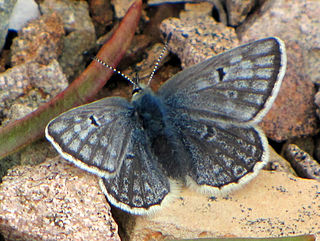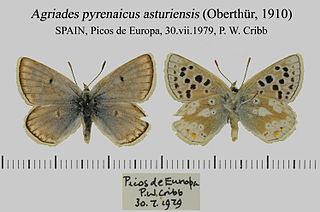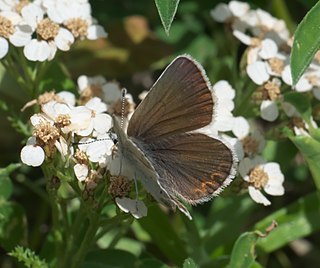
Lycaenidae is the second-largest family of butterflies, with over 6,000 species worldwide, whose members are also called gossamer-winged butterflies. They constitute about 30% of the known butterfly species.

The Karner blue is an endangered subspecies of small blue butterfly found in some Great Lakes states, small areas of New Jersey, the Capital District region of New York, and southern New Hampshire, where it is the official state butterfly. The butterfly, whose life cycle depends on the wild blue lupine flower, was classified as an endangered species in the United States in 1992.

The silver-studded blue is a butterfly in the family Lycaenidae. This eye-catching butterfly has bright blue wings rimmed in black with white edges and silver spots on its hindwings, lending it the name of the silver-studded blue. P. argus can be found across Europe and Asia, but is most often studied in the United Kingdom in which the species has experienced a severe decline in population due to habitat loss and fragmentation.

Pine barrens, pine plains, sand plains, or pinelands occur throughout the U.S. from Florida to Maine as well as the Midwest, West, and Canada and parts of Eurasia. Pine barrens are plant communities that occur on dry, acidic, infertile soils, dominated by grasses, forbs, low shrubs, and small to medium-sized pines. The most extensive barrens occur in large areas of sandy glacial deposits, lakebeds, and outwash terraces along rivers.

Draycott Sleights is a 61.95 hectares biological Site of Special Scientific Interest at Draycott in the Mendip Hills, Somerset, England, notified in 1987.

Lupinus perennis is a flowering plant in the family Fabaceae. It is widespread in the eastern part of the USA and Minnesota, Canada, and on the coasts of the Arctic Ocean, where it grows in sandy areas such as dunes and savannas.

Agriades is a genus of butterflies in the family Lycaenidae. Its species are found in Asia, Europe, and North America.
The Alpine zephyr blue is a species of butterfly in the family Lycaenidae. It is found in Italy and Switzerland. Its natural habitats are temperate forests and temperate grassland. It is threatened by habitat loss.

Plebejus is a genus of butterflies in the family Lycaenidae. Its species are found in the Palearctic and Nearctic realms.

Plebejus argyrognomon, common name Reverdin's blue is a butterfly of the family Lycaenidae. The species is named after Jacques-Louis Reverdin.

Plebejus idas, the Idas blue or northern blue, is a butterfly of the family Lycaenidae.

Karner is a hamlet of the town of Colonie, Albany County, New York. Once called Center Station it was a stop along the New York Central Railroad (NYCRR) that became famous for being the site where the Karner Blue butterfly was first identified.

Icaricia icarioides, or Boisduval's blue, is a butterfly of the family Lycaenidae found in North America. This butterfly has 25 recognized subspecies.

Agriades pyrenaicus, the Gavarnie blue, is a Palearctic butterfly of the family Lycaenidae. It is found in the Asturias mountains of north-western Spain, the Pyrenees, the southern Balkan Peninsula, Turkey, the Caucasus and Armenia. The habitat consists of alpine grassy rocky meadows where it is found at altitudes ranging from 1,500 to 2,200 meters.

Kretania sephirus, previously known as Plebejus sephirus, is a species of butterfly that belongs to the family Lycaenidae. It is found in Eastern Europe, the Caucasus, and Asia Minor. The species is part of a species complex, with many members of the complex using variations of the name zephyr blue, including pylaon, trappi, and hesperica. The species, which previously belonged to the genus Plebejus, was moved to the genus Kretania following a 2013 molecular phylogenetics study of the subtribe Polyommatina. Many sephirus populations are threatened, and are legally protected in some countries, such as Hungary.

Plebejus anna, or Anna's blue, is a species of blue in the butterfly family Lycaenidae. It is found in North America.
Plebulina emigdionis, the San Emigdio blue, is a species of blue in the family of butterflies known as Lycaenidae. It is the sole representative of the monotypic genus Plebulina. It is found in North America.
Icaricia neurona, the veined blue, is a species of blue in the butterfly family Lycaenidae. It is found in North America.


















